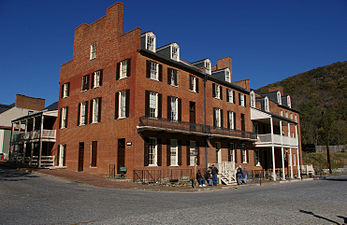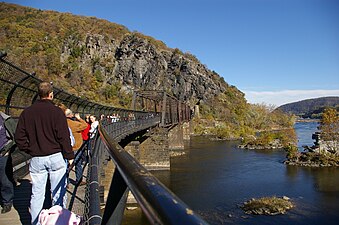Harpers Ferry National Historical Park
This article needs additional citations for verification. (August 2011) |
| Harpers Ferry National Historical Park | |
|---|---|
Harpers Ferry | |
| Location | Maryland, Virginia, and West Virginia |
| Coordinates | 39°19′22″N 77°43′47″W / 39.32278°N 77.72972°W |
| Area | 3,660.73 acres (14.8144 km2)[1] |
| Established | June 30, 1944 |
| Visitors | 407,008 (in 2022)[2] |
| Governing body | National Park Service |
| Website | Harpers Ferry National Historical Park |
Harpers Ferry National Historical Park | |
| Location | Confluence of the Potomac and Shenandoah rivers Harpers Ferry, West Virginia |
| NRHP reference No. | 66000041[3] (original) 16000238 (increase) |
| Significant dates | |
| Added to NRHP | October 15, 1966 |
| Boundary increase | May 10, 2016 |
Harpers Ferry National Historical Park, originally Harpers Ferry National Monument, is located at the confluence of the Potomac and Shenandoah rivers in and around Harpers Ferry, West Virginia. The park includes the historic center of Harpers Ferry, notable as a key 19th-century industrial area and as the scene of John Brown's failed abolitionist uprising. It contains the most visited historic site in the state of West Virginia, John Brown's Fort.[4]
The park includes land in the
The park was originally planned as a memorial to John Brown, responsible for what is by far the most famous incident in Harpers Ferry's history, his 1859 raid and capture of the federal armory. NPS officials in the 1930s focused on John Brown's raid and the Civil War to justify acquiring parts of Harpers Ferry for a historical and military park. Like the figure of John Brown himself, this proved enormously controversial, with opposition from organizations such as the United Daughters of the Confederacy and the Sons of Confederate Veterans.[8]: 86
Early history
Today, the original house built by Robert Harper is the oldest remaining structure in the lower part of the park. George Washington visited the area during his trip to the rivers' confluence in 1785, searching for a waterway to ship goods westward. Later, Washington began the construction of the federal Harpers Ferry Armory on the site, utilizing waterpower from the rivers for manufacturing purposes.
John Brown's raid and the American Civil War

Abolitionist

The
Storer College

Storer College was built in Harpers Ferry as one of the first
The park today

Several historical museums now occupy restored 19th century buildings in the Lower Town Historic District of Harpers Ferry. Nearly half a million people visit the park each year.
The
Lower town sites


The Lower Town points of interest are clustered where the Shenandoah River meets the Potomac River, and run along Shenandoah Street, Potomac Street and High Street.
- Information Center
- Restoration Museum
- Frankel's Clothing Store
- Industry Museum
- Bookshop
- Blacksmith Shop
- Hamilton Street
- A Place in Time Museum
- Provost Marshal Office
- Stipes’ Boarding House
- Dry Goods Store
- Arsenal Square
- John Brown's Fort
- The Point
- John Brown Museum
- Wetlands Museum
- Storer College/Niagara Movement Museum
- A. Burton Clocks and Jewelry Exhibit
- 1862 Battle of Harpers
- Ferry Museum
- Confectionery Exhibit
- Civil War Museum
- Black Voices Museum
- White Hall Tavern
- Meriwether Lewis Exhibit
- Harper House
- Jefferson Rock
- Harper Cemetery
Virginius Island
Virginius Island was a thriving, water-powered manufacturing center before the Civil War. Economically it was always part of Harpers Ferry, and the Harpers Ferry station of the Winchester and Potomac Railroad was on Virginius Island, through which its track ran; the rail line, although rebuilt, is still in daily use. It was a working-class community. The island's industries declined after the Civil War, and successive floods destroyed the industries. After the flood of 1936 no structure remained standing and there were no remaining residents.
The National Park Service has studied the industrial and sociological history of Virginius Island in depth. Many ruins have been stabilized and signed, footbridges and paths maintained. It can be visited on a walking tour.
Gallery
-
Harpers Ferry entry sign
-
High Street, looking north (downhill) towards the Potomac River and Maryland
-
Shenandoah Street and Lower Town, looking south (uphill) towards West Virginia
-
White Hall Tavern
-
White Hall Tavern
-
The Dry Goods Store
-
Wetlands Exhibit
-
The CSX railroad bridge crosses the Potomac River on the edge of the park
-
View from Jefferson Rock
-
View from Maryland Heights
See also
- Harpers Ferry Historic District
- Heyward Shepherd monument
- John Brown's Fort
- John Brown's raid on Harpers Ferry
- Journey Through Hallowed Ground National Heritage Area
- Storer College
References
Notes
- ^ "Listing of acreage – December 31, 2011" (XLSX). Land Resource Division, National Park Service. Retrieved 2012-06-16. (National Park Service Acreage Reports)
- ^ "NPS Annual Recreation Visits Report". National Park Service. Retrieved 2023-08-05.
- ^ "National Register Information System – (#66000041)". National Register of Historic Places. National Park Service. November 2, 2013.
- ^ "John Brown". e-WV: The West Virginia Encyclopedia. December 5, 2017. Retrieved April 18, 2021.
- ^ Jefferson, Thomas (1829). Notes on the State of Virginia, p. 17. Wells and Lilly, Boston.
- ^ Snell, Charles W.; Mackintosh, Barry (June 1980). "National Register of Historic Places Inventory/Nomination: Harpers Ferry National Historical Park". National Park Service. With accompanying 114 photos
- ^ Quigley, Aiden (April 3, 2017). "Spicer: Trump donating first-quarter salary to National Park Service". Politico. Retrieved April 3, 2017.
At the start of the daily White House press briefing, Spicer handed a check for $78,333.32 to Secretary of the Interior Ryan Zinke and Tyrone Brandyburg, the superintendent of Harpers Ferry National Historical Park in West Virginia.
- OCLC 1058473018.
- ^ "Storer College Site Bulletin" (PDF). NPS. Retrieved May 27, 2012.
- ^ "Storer College". Harpers Ferry NHP. National Park Service. Retrieved May 27, 2012.
- ^ "Harpers Ferry National Historical Park: Your Dollars At Work". National Park Service. Retrieved 2011-08-21.
- ^ "Washington, DC, Facts". Washington DC Go!. Archived from the original on 2011-08-07. Retrieved 2011-08-21.
- ^ [1] American Battlefield Trust "Saved Land" webpage. Accessed May 25, 2018.
Further reading
- National Park Service (2018). "Harpers Ferry and the Civil War Chronology". Retrieved May 21, 2021.
- Moyer, Teresa S.; Wallace, Kim E.; Shackel, Paul A. (2004). "To Preserve the Evidences of a Noble Past": An Administrative History of Harpers Ferry National Historical Park (PDF). Catoctin Center for Regional Studies, University of Maryland.
- National Park Service (1957). Harpers Ferry National Monument. United States Department of the Interior, National Park Service.
External links
- Harpers Ferry National Historical Park – official site
- Harpers Ferry Historical Association – friends site, features interactive guide to the park
- Historic American Buildings Survey (HABS) No. WV-224, "Harpers Ferry National Historical Park, General Views, Shenandoah Street, Harpers Ferry, Jefferson County, WV", 8 photos, 5 color transparencies, 6 data pages, 4 photo caption pages















